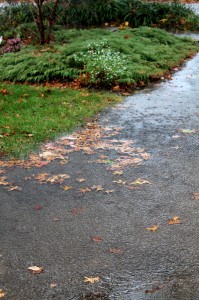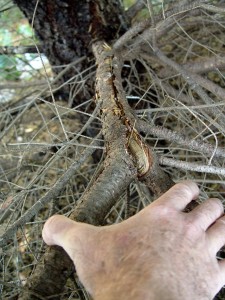Yard Cleanup After Sandy
October 30th, 2012
Didn’t we just go through all of this? First Irene, then Lee, now Sandy… not to mention the unnamed weather woes before and between.
Here’s hoping you aren’t facing disastrous difficulties this time around and are looking only at some garden-variety yard cleanup as Sandy blows away. Indications are that this “superstorm” could’ve been a lot worse than it turned out.
Some tips on assorted post-Sandy situations:
Fixing Washouts
If rushing water cut channels in bare soil, rake and tamp what you can salvage back into place. Then prevent a repeat by: 1.) rerouting or mitigating the source of the gusher; 2.) grassing or mulching bare soil, or 3.) laying stone on top of landscape fabric to create a dry stream bed that won’t wash out in the next storm.
For newly planted shrubs and perennials that washed out, retrieve and replant them ASAP. Also check plants for soil or mulch that partially washed out, exposing roots. If you get these surrounded by soil quickly, most washouts will be fine.
If you can’t get washed-out plants back into their permanent home yet because the soil is still soggy, at least get them in a pot or planted in higher, drier ground.
Soggy Soil
Some plants tolerate occasional “wet feet.” Others, such as many conifers and plants native to dry meadows, begin to root-rot after a day or two in standing water.
Cutting a single drainage channel to release backed-up water might be helpful. But poking a lot of holes around your plants in an attempt to “air out” the soil faster probably will do more root harm.
Stay off soggy soil so you don’t compact it and compound the problem even after the water drains.
Make a note to watch trees that were in soggy soil. Partial root death can compromise the tree’s stability. That might not be apparent until next spring when trees re-leaf and become more at risk from blow-over related to a greater “sail effect” with a full canopy.
Leaf Mess
Sandy came at a time when leaf drop was peaking. Her winds also blew off a lot more, resulting in gobs of wet leaves everywhere now. That became a problem for drivers since wet leaves on the road make for slippery conditions. Be careful of that if you’re out on the road until the leaves dry and get collected.
Once you get outside, first clear the way to storm drains and unblock gutters and drains before another rain comes along.
Then rake off or blow off piles and mats of leaves that are covering the lawn and groundcover beds. Thin layers can be mowed into the lawn once it dries. Two- to 3-inch layers are fine left as insulation in tree, shrub and perennial beds.
Compost whatever leaves you don’t mow in or let behind as mulch. At least hold off raking and blowing leaves to the curb until you’ve got word that your municipality is resuming leaf collections.
Battered Trees
Survey the landscape to determine how your trees fared.
Don’t attempt to climb trees with a chainsaw to remove hangers or to clean up branch breaks. Let trained, secured and insured pros handle that. Yeah, it can get expensive, but at least it’s cheaper than a hospital stay for a broken back.
Limit yourself to pruning and repairing problems that you can reach from the ground.
Some branch splits can be fixed. Pull split parts back together and either 1.) wrap tightly with burlap or soft cloth, or 2.) secure them with bolts. If the repair is made before the inside wood calluses over, the broken branch has a good chance of growing back together. Wraps can be removed next summer. Bolts can stay in.
Badly broken branches should be cut off cleanly – ideally back to live, uninjured growth or back nearly flush with the main trunk if it’s a large branch.
Try to cut at a joint (where two branches meet) or back to just outside the little ring where a large branch attaches to the trunk.
Tar or similar tree paint isn’t needed. Just let the clean, sharp cut air-dry.
Leaners and Blow-Overs
If winds blew over shrubs or recently planted small trees, replant them, tamp the soil and stake for the winter. They’ll likely recover.
Ditto for shrubs and young trees that are leaning. Straighten them, tamp and stake.
For bigger trees (i.e. ones big enough to damage a target if it were to fall), these are much less likely to re-root. Big leaners are a particular threat. Get an assessment from a reputable tree company ASAP, and keep people, cars, etc. away from them in the meantime.
Also be wary of untrained, uninsured and over-charging “tree companies” going around soliciting work.
Flooded Gardens
Scrap fruits, vegetables and herbs submerged or splashed by flood waters. Tomatoes, peppers, squash and similar above-ground crops are less of a threat than low-to-the-ground leafy crops, such as lettuce, chard, spinach, collards, kale, parsley and broccoli. These are more likely to be contaminated, especially by possible pollutants in creek water.
In theory, you should be able to give everything a good scrubbing and eat away. In reality, pollutants can get trapped in the nooks and crannies of plant parts and even get absorbed into the flesh of skinned fruits.
Cooking or disinfecting kills bacterial pollutants, but the problem is that’s not all that might be in flood water.
Avoid digging in or walking on soil while it’s still wet. Wash well immediately after working in a flooded garden, and get those dirty clothes right into the washing machine, not the hamper.
Soil is an excellent contaminant filter, so your flooded garden will be fine to replant next spring. Between weather exposure and soil microbes, most pathogens are dead in 90 days.
Lessons Learned
Use Sandy’s lessons to head off future trouble.
Were your gutters adequate? If you can’t keep up with clearing the gutters of leaves, maybe it’s time to install screening or similar protection.
Did your down spouts and drains move roof drainage away from the house? If not, consider extending them and adding a cutout of stones at the end to slow the discharge.
Is your yard draining properly away from the house or do you need some rerouting and/or regrading?
Should you add more rain-absorbing gardens to replace compacted lawn space? Or is it time to rent a core aerator to improve lawn drainage?
Did your rain barrels function properly? If not, come up with a better overflow system or remember to unhook them and go back to your spout discharge next time the barrels are full and a heavy rain is forecast.
Check out wet spots. This is a good clue for future plant selection. Wet spots call for species that can tolerate occasionally wet feet.
Wet spots also might be good spots for a rain garden? Click here for more on that.










